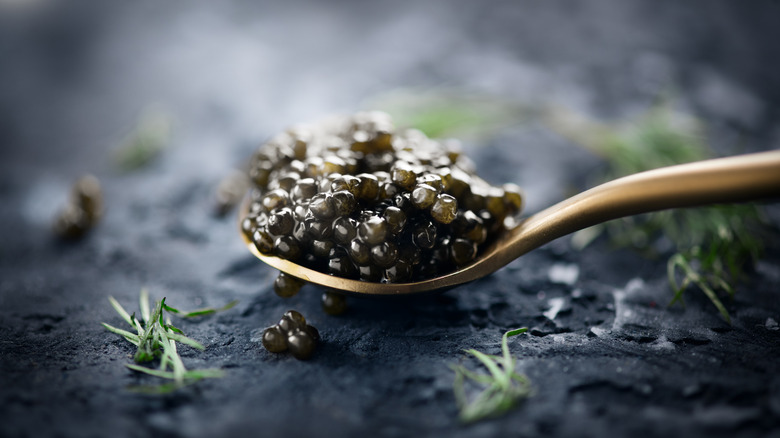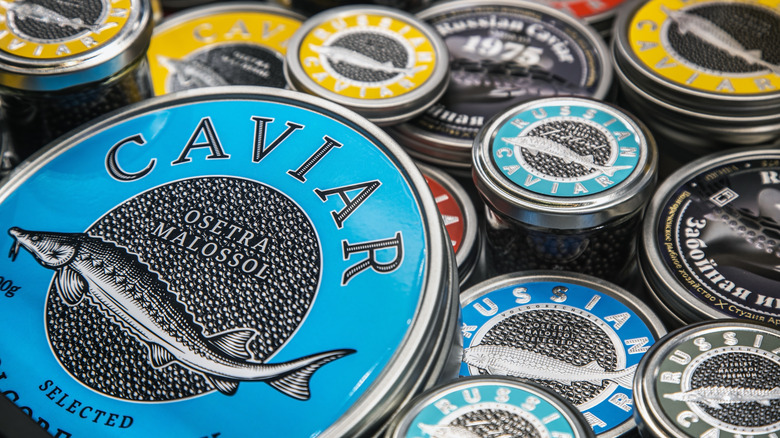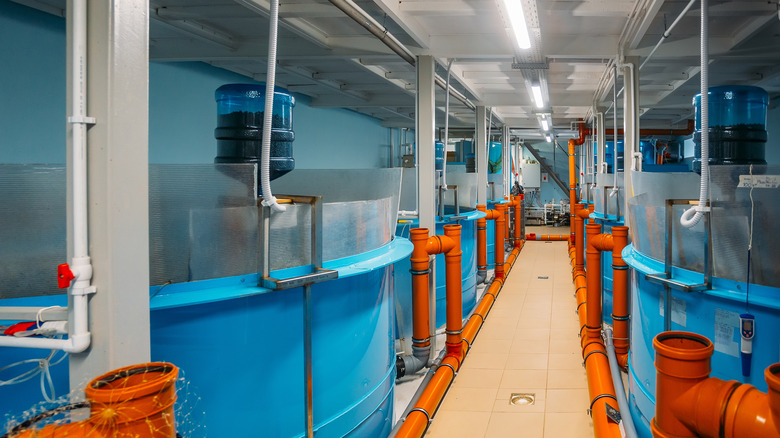Why You Should Think Twice Before Eating Caviar
Pinkies up, y'all! It's time to talk about caviar. Language and food are indivisibly intertwined. Have you ever noticed how there are some words that are so tied to a particular trope they become almost inseparable from their associated meaning? A mere utterance of certain words can immediately conjure visions of opulence and grandeur. Champagne? Definitely. Soirée? Perhaps. Caviar? Of course, dahling.
But caviar is no longer just the illustrious garnish on canapes or a showy service offered at lofty Michelin star restaurants. A decade ago, Marketing Week made note of the cool, high-brow-meets-low-brow concept that has become part of the world of food and beverage, showcasing unlikely combinations like champagne and hot dogs, or football and wine. It wasn't too long ago that Paste Magazine predicted that caviar would become a regular brunch item or replace cocktails and avocado toast. And while we are most definitely here for the restaurant industry to make elements of fine dining more accessible, we should not overlook the harvesting of caviar, as it totes a nefarious underbelly that might give you pause before dipping your chip.
How is caviar harvested?
Caviar, with all of its prestige and hullabaloo, is very simply salted and cured fish eggs — otherwise known as roe (via House of Caviar and Fine Foods). While roe can be collected from a variety of fish, a sturgeon's is the most quintessential and sought after. As roe refers to the unfertilized, internal eggs inside the ovaries of a fish, you can imagine there are only invasive ways to collect them.
According to The Guardian, as recently as 15 years ago, the harvesting process was ruthless, with fishermen in the Caspian and Black seas heaving beluga sturgeon from the water, slicing out their roe sacs, and tossing them back in the ocean to die (via Caviar Star). This was done with such rigor that these gentle giants — creatures that have been around since the time of dinosaurs — were driven to the brink of extinction, per World Wide Fund for Nature. The Guardian reports that the international trade of wild sturgeon was banned in 2006, making it illegal for sturgeon to be caught and killed in the wild. However, with humans not to be financially thwarted, sturgeon farms began popping up across the globe. Sturgeon farming is certainly more sustainable than slaughtering the fish en masse, however, the methods used for extracting the eggs raise ethical questions in regard to caviar.
Is sturgeon farming ethical?
The farming of sturgeon for caviar does not mean the end of killing sturgeon for caviar. However, some farms have tried to shift to a "no-kill" model, which is intended to be more humane. According to NPR, there are two methods of extracting sturgeon eggs: the C-Section or the vivace method. During a C-Section, an incision is made, the eggs are scooped out, and the fish is bandaged and put back. If she doesn't die from infection or damage to her internal organs, she will be ready to repeat the process in just 15 months. With the vivace method, the eggs are massaged out of the fish after she's chemically induced.
Even with no-kill caviar entering the scene, the process of farming fish and extracting their eggs via surgery or chemical induction every 15 months sounds the alarm for PETA intervention, no? Especially considering Smithsonian Magazine's confirmation that fish can, in fact, feel pain, despite earlier claims that they couldn't. Of course, we wouldn't dream of crushing your caviar cravings, especially if you find some that are ethically sourced! Just offering a little caviar-topped-canape for thought.



